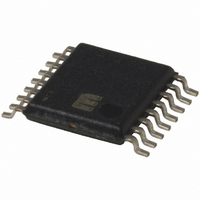MIC2584-JBTS Micrel Inc, MIC2584-JBTS Datasheet - Page 25

MIC2584-JBTS
Manufacturer Part Number
MIC2584-JBTS
Description
IC CTRLR HOT SWAP DUAL 16-TSSOP
Manufacturer
Micrel Inc
Type
Hot-Swap Controllerr
Datasheet
1.MIC2584-JYTS.pdf
(28 pages)
Specifications of MIC2584-JBTS
Applications
General Purpose
Internal Switch(s)
No
Voltage - Supply
1 V ~ 13.2 V
Operating Temperature
-40°C ~ 85°C
Mounting Type
Surface Mount
Package / Case
16-TSSOP
Linear Misc Type
Positive Low Voltage
Family Name
MIC2584
Package Type
TSSOP
Operating Supply Voltage (min)
1V
Operating Supply Voltage (max)
13.2V
Operating Temperature (min)
-40C
Operating Temperature (max)
85C
Operating Temperature Classification
Industrial
Product Depth (mm)
4.4mm
Product Height (mm)
0.9mm
Product Length (mm)
5mm
Mounting
Surface Mount
Pin Count
16
Lead Free Status / RoHS Status
Contains lead / RoHS non-compliant
Available stocks
Company
Part Number
Manufacturer
Quantity
Price
Company:
Part Number:
MIC2584-JBTS
Manufacturer:
MIC
Quantity:
23
Company:
Part Number:
MIC2584-JBTS
Manufacturer:
MICREL
Quantity:
240
Part Number:
MIC2584-JBTS
Manufacturer:
MICREL/麦瑞
Quantity:
20 000
higher pulsed power without damage than its continuous
dissipation ratings would imply. The reason for this is that, like
everything else, thermal devices (silicon die, lead frames,
etc.) have thermal inertia.
In terms related directly to the specification and use of power
MOSFETs, this is known as “transient thermal impedance,”
or Z
Transient Thermal Impedance Curve. For example, take the
following case: V
I
nominal, and the fast-trip threshold is 100mV. If the output is
accidentally connected to a 6 load, the output current from
the MOSFET will be regulated to 1.2A for 100ms (t
before the part trips. During that time, the dissipation in the
MOSFET is given by:
At first glance, it would appear that a really hefty MOSFET is
required to withstand this sort of fault condition. This is where
the transient thermal impedance curves become very useful.
Figure 13 shows the curve for the Vishay (Siliconix) Si4410DY,
a commonly used SO-8 power MOSFET.
Taking the simplest case first, we’ll assume that once a fault
event such as the one in question occurs, it will be a long time,
10 minutes or more, before the fault is isolated and the
channel is reset. In such a case, we can approximate this as
a “single pulse” event, that is to say, there’s no significant duty
cycle. Then, reading up from the X-axis at the point where
“Square Wave Pulse Duration” is equal to 0.1sec (=100msec),
we see that the Z
event of this duration is only 8% of its continuous R
This particular part is specified as having an R
50 C/W for intervals of 10 seconds or less. Thus:
Assume T
drain leads, no airflow.
March 2005
MIC2584/2585
LOAD(CONT. MAX)
(J-A)
P = E x I E
P
MOSFET
. Almost all power MOSFET data sheets give a
A
= 55 C maximum, 1 square inch of copper at the
= (4.8V x 1.2A) = 5.76W for 100msec.
IN
MOSFET
(J-A)
is 1.2A, the slow-trip threshold is 50mV
= 12V, t
of this MOSFET to a highly infrequent
0.01
0.1
= [12V-(1.2A)(6 )] = 4.8V
2
1
OCSLOW
10
—4
Duty Cycle = 0.5
0.2
0.1
0.05
0.02
has been set to 100msec,
Normalized Thermal Transient Impedance, Junction-to-Ambient
Single Pulse
10
Figure 13. Transient Thermal Impedance
—3
OCSLOW
10
Square Wave Pulse Duration (sec)
(J-A)
(J-A)
—2
.
of
)
25
Recalling from our previous approximation hint, the part has
an R
Assume it has been carrying just about 1.2A for some time.
When performing this calculation, be sure to use the highest
anticipated ambient temperature (T
MOSFET will be operating as the starting temperature, and
find the operating junction temperature increase ( T
that point. Then, as shown next, the final junction temperature
is found by adding T
form equation, getting a close approximation may take one or
two iterations, But it’s not a hard calculation to perform, and
tends to converge quickly.
Then the starting (steady-state)T
Iterate the calculation once to see if this value is within a few
percent of the expected final value. For this iteration we will
start with T
So our original approximation of 56.4 C was very close to the
correct value. We will use T
Finally, add (5.76W)(50 C/W)(0.08) = 23 C to the steady-state
T
maximum junction temperature for this part.
10
J
—1
to get T
ON
T
T
T
T
T
J
J
J
J
J
of (0.0335/2) = 17m
( 55 C + (0.02832W)(50 C/W)
T
T
55 C + [17m + (55 C-25 C)(0.005)(17m )]
(55 C + (0.02815W)(50 C/W)
54.6 C
T
J
J(TRANSIENT MAX.)
A(MAX)
A(MAX)
A
equal to the already calculated value of 54.6 C:
+ [17m + (54.6 C-25 C)(0.005)(17m )]
x (1.2A)
1
x (1.2A)
Notes:
1. Duty Cycle, D =
2. Per Unit Base = R
3. T
4. Surface Mounted
P
DM
+ T
+ [R
x I
A(MAX)
JM
— T
2
t
2
1
A
x R
ON
= P
t
J
2
x (50 C/W)
2
DM
Z
x (50 C/W)
and T
+ (T
thJA
J
t
t
thJA
(J-A)
1
2
10
(t)
= 56 C.
= 50
= 79 C. This is an acceptable
A(MAX)
at 25 C.
¡
C/W
J
J
. Since this is not a closed-
30
is:
– T
A(MAX)
A
)(0.005/ C)(R
56.42 C
) in which the
MIC2584/2585
J
) from
Micrel
ON
)]











